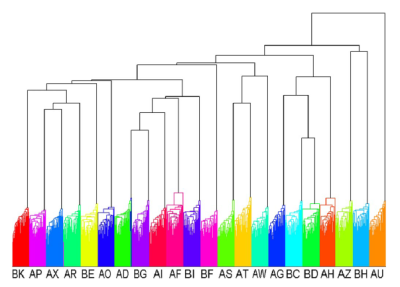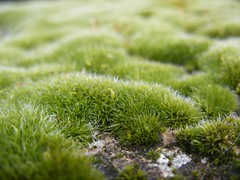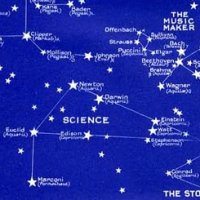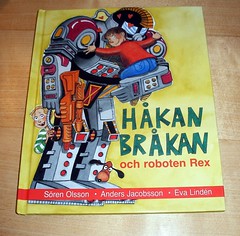January 31, 2008
People are Chemically Consistent
Evidence of different metabolic phenotypes in humans -- Assfalg et al., 10.1073/pnas.0705685105 -- Proceedings of the National Academy of Sciences shows that the biochemical differences between people are larger than the biochemical differences that occur from day to day due to diet, lifestyle and other factors. We seem to have metabolic fingerprints that at least don't change over the span of months. This might be useful for pharmacology, nutrition and medicine if we can figure out what metabolic fingerprints make us more or less vulnerable to different things.
The researchers took urine samples from 22 healthy volunteers over the span of three months. These were measured using NMR, and the spectra were then analysed using PCA, HCA, clustering and the usual statistical rigmarole.

I think the nicest diagram in the paper is this dendrogram, showing how close different samples are to each other. Different people have been given different colour, and the height of the branchings show how far away from each other the different clusters are. Clearly people are more chemically consistent with themselves than their "chemical neighbours".
I wonder if this could be used as biometrics? It might be individually reliable unless you happen to switch eating habits but just looking at a spectrum might not give enough dimensions to discriminate all people. Most likely it is best for research or as part of data fusion biometrics. But it would be amusing with high-security facilities that required peeing in a receptacle in order to open the security door...
January 28, 2008
Salt of the Earth
 Another reason some forms of religion are harmful:
Another reason some forms of religion are harmful:
Y. Ofran, D. Lavi, D. Opher, T. A. Weiss & E. Elinav, Fatal voluntary salt intake resulting in the highest ever documented sodium plasma level in adults (255 mmol L−1): a disorder linked to female gender and psychiatric disorders, J Intern Med, 256:6 pp 525-528, December 2004 (via A Good Poop).
The paper describes how a woman with post-natal depression ingested large quantities of salt in an exorcism ritual. This killed her. The interesting thing is that normally salt is emetic - it is hard to keep down. The paper comments:
The ability to consume such large quantities of salty water is peculiar. The ‘spiritual’ environment and the attendance of a large number of close family members in the exorcism ceremony might have prompted the patient to resist her natural distaste and ingest the highly salty beverage. The patient's depressive disorder may have contributed to her obedience and compliance with the drinking, whilst depression has been suggested to alter the sense of taste in a minority of individuals.
Reviewing previous cases of death by salt overdose, the paper notes that beside another exorcism where the victim was forced to ingest salt (this time as a 'treatment' for epilepsy) and a case of a fisherman swallowing much salt water, all other cases had patients suffering from cognitive or psychiatric disorders. Having a mental disorder seems to increase the risk of being salt poisoned by enabling consumption (either voluntarily or religiously coercively).
While salt poisoning is tricky, the widespread availability of this poison (that contains chlorine, quick, call Greenpeace!) suggests that people may be poisoning themselves and others far more than we might expect. An interesting paper, Yvan Gaillard, Ananthasankaran Krishnamoorthy and Fabien Bevalot, Cerbera odollam: a ‘suicide tree’ and cause of death in the state of Kerala, India, Journal of Ethnopharmacology Volume 95, Issues 2-3, December 2004, Pages 123-126 (this one via Drugs and Poisons) noted:
A close perusal of the statistical data on poisoning cases shows that ease of availability is the main factor determining the choice of poison for suicide or homicide. For example, in 65–70% of poisoning cases in Kerala, the toxins used are insecticides that are easily available to farmers. In the Kottayam and Idukki districts of central Kerala, however, where there are many rubber estates, more people use the so called ‘rubber acids’ (acetic acid and formic acid used for processing rubber latex) for committing suicide, while in Palakkad district the use of Thevetia peruviana (yellow oleander) is more widespread because of its natural abundance there. Those with access to goldsmiths use cyanide, since goldsmiths are licensed to possess it for purifying gold and electroplating. Those working in automobile electric workshops use sulphuric acid (battery acid), while the elite class tend to use drug overdoses.It can thus be said that the availability of the poison and the victim's social and educational status play a role in the choice of the poison selected for committing suicide, although no distinction can be drawn caste-wise, since people of all castes in Kerala's coastal areas and backwaters commit suicide by taking odollam.
Suicide by drinking acetic acid? Suicide by sulphuric acid? People have to be really desperate to do that. But if ease of access is a key factor compared to horribleness of dying, then there ought to be a lot more salt suicides we have not noticed.
Apropos A Good Poop: what happened to Beavis & Butthead? They began to study medicine, became fratboys and realized that Medline abstracts could be hilarious. And none of us can stay away from this kind of juvenile medicine :-)
January 23, 2008
Not Easy to be NICE
On CNE I blog about how the UK House of Commons health select committee is suggesting changing things for NICE.
Last week I blogged there about recycling hearts.
I'm Not a Number; I'm a Bunch of Personas!
A practical ethics blog: practicalethics: I'm Not a Number; I'm a Human Being: RFID Tags and Our Personas. My argument is that what is important is our ability to shift social personas rather than privacy per se.
January 15, 2008
Fun in Medicine
 This week Nature Medicine had a few fun results.
This week Nature Medicine had a few fun results.
The one with the highest gosh-factor was of course Perfusion-decellularized matrix: using nature's platform to engineer a bioartificial heart by Ott et al: they cleaned out rat hearts with a detergent, making a perfect scaffolding to grow new cells on. While it isn't that hard to get spontaneous beating of myocardial cultures (if I understand right) this actually produces the right architecture of an entire organ, which is far more impressive. Obvious scaling issues of course.
It turns out that Adenosine is crucial for deep brain stimulation–mediated attenuation of tremor - the electrical signals cause release of ATP, which is broken down to adenosine, which depresses synaptic excitatory transmission. So the effect of the electrode is not entirely due to the signal but simply that it tires out the local neurons. This explains why the form of the signal doesn't seem to matter that much. I wonder how DBS reacts to coffee drinking?
Finally, a group of researchers found a signal pathway required for salt-induced hypertension. Apparently it does not regulate basal blood pressure, so treatments targeting it might not have hypotensive effects. Sounds good, I like salt.
January 08, 2008
A Better Sky
 I'm very fond of Strange Maps, but it focuses mainly on odd Earth maps. Here is an unusual sky map.
I'm very fond of Strange Maps, but it focuses mainly on odd Earth maps. Here is an unusual sky map.
This is the revised sky map proposed by Sir Alan Patrick Herbert in 1944, intended to make people more interested in astronomy by making the stars and constellations easier to remember. He published it in the book A Better Sky. A review can be found in The Observatory 65, p. 150-1, 1944.
The basic idea is to throw out those old and strange star and constellation names in favor of modern, exciting names like The Sailor for Orion, renaming Betelgeuse Nelson and Rigel to Drake. Scorpio becomes The Painter, a new constellation named Europe Regained stretches from Paris (Vega) to Rome (Cor Caroli). And the great bear becomes Great Britain. Even Robespierre, Tamburlaine, Mussolini, Hitler, Atilla and Kublai Khan get their own constellation, The Tyrants.
Strangely, it was not a success.
January 05, 2008
Heteronormativity in Preschool Robotics
 One of my duties as uncle is the reading of bedtime stories. Sometimes I'm amazed by the content. Håkan Bråkan och roboten Rex by Sören Olsson, Anders Jacobsson and Eva Linden is an interesting take on queer robotics as male capitulation in the kindergarten matriarchy.
One of my duties as uncle is the reading of bedtime stories. Sometimes I'm amazed by the content. Håkan Bråkan och roboten Rex by Sören Olsson, Anders Jacobsson and Eva Linden is an interesting take on queer robotics as male capitulation in the kindergarten matriarchy.
The basic story is about Håkan who has a cool killer robot toy he wants to bring to his preschool. But the rules are strict: no toy weapons, no toys relating to war or violence in any form. Håkan of course disobeys, trying to sneak his dear robot under the radar or claim it is not a warlike machine (despite the nuclear death rays and the "Freeze, or I will shoot!" voice). In a series of scenes depicting the unreliability of friends, the manipulative power of the teacher, girl peer pressure and Håkan's desperate attempts to avoid cooties Rex the killer robot ends up Brandon the love robot and finally just Rex the comic relief robot. It is a powerful portrait of how some men experience the total loss of their power to define the meaning of their gender to hegemonic political correctness.
Perhaps the most disturbing aspect of the book is the deeply entrenched gender stereotypes of the preschool. While the kids are individually quite themselves, as groups they organize into marriage and romance obsessed girls and the violence and adventure obsessed boys. I actually felt while reading it to my niece that it would have been more refreshing to break these stereotypes than to reinforce them. The transformations (or rather, emasculation) of Rex only underscores this: Rex may end up a rather queer robot, but that is only allowed by the preschool microsociety because it becomes funny and unthreatening - the nice gay guy. In the end the matriarchy stands unchallenged, tolerant heteronormativity still remains and Håkan has learned to trust and love Big Mother.